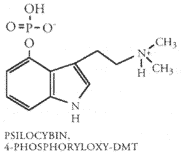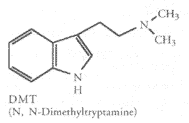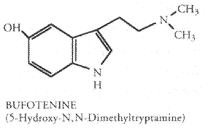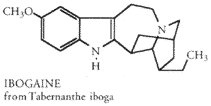Neuro-Alchemy: Beta-Carbolines as Potentiating Agents
by J.B. Fleming
"I began to get high-and then the whole fucking Cosmos broke loose around me" —Allen GinsbergDuring the nineteen twenties, ethnographers returning from the Amazon jungle gave strange accounts of tribal shamans who used a telepathy-increasing plant drug to direct the course of their societies. The drug was a hallucinogenic drink which had several different native names including Ayahuasca, Yage, Caapi, and Natema. It was brewed from a species of woody vine called Banisteriopsis along with various admixtures which commonly included the leaves of Banisteriopsis rusbyana, Psychotria viridis, and Brugmansia.
Native users of ayahuasca were reported to experience collective hallucinations of jaguars, snakes, and jeweled birds. These visions were often accompanied by contact with dead ancestors, the ability to see future events, and telepathic communication among tribal members. Secondary effects included heightened sexual responses, vomiting and diarrhea. Ayahuasca's purgative effects also made it useful as a general medicine to stimulate health and fight diseases.
 Toxicologists were fascinated by the drug and soon extracted the active
compound from the Banisteriopsis vine, naming it Telepathine. However, in
the nineteen thirties, research interest in ethnopharmacology faded and the
matter was left to rest. The case on ayahuasca was reopened in 1957 when
researchers discovered that Telepathine was actually Harmine, one of
several compounds from the beta-carboline family of hallucinogens.
Secondary alkaloids called Harmaline and Tetrahydroharmine were also
identified.
Toxicologists were fascinated by the drug and soon extracted the active
compound from the Banisteriopsis vine, naming it Telepathine. However, in
the nineteen thirties, research interest in ethnopharmacology faded and the
matter was left to rest. The case on ayahuasca was reopened in 1957 when
researchers discovered that Telepathine was actually Harmine, one of
several compounds from the beta-carboline family of hallucinogens.
Secondary alkaloids called Harmaline and Tetrahydroharmine were also
identified.
The beta-carbolines were first isolated in 1841 from the seeds of Peganum harmala, a small, bushy herb known as Syrian Rue which grows along the Mediterranean and throughout Central Asia. It is also reported to have escaped cultivation and can now be found throughout the American southwest. Middle Eastern people have long used Syrian Rue as a folk medicine and for the unique red dye in Turkish and Persian rugs. Egyptians employed the seeds as an aphrodisiac and the plant has been considered as a possible (although unlikely) candidate for the mysterious Soma described in the Rig-Veda. Beta-carbolines have since been identified in several more plants including Passionflower (Passiflora incarnata), Tobacco (Nicotiana rustica), and even within the human pineal gland.

    |
Monoamine oxidase (MAO) is an enzyme produced in the human body which serves several regulatory functions. Within the nerve terminals of norepinephrine, dopamine, and serotonin neurons MAO acts to modulate the amount of neurotransmitter present. MAO bonds with the transmitters and deactivates them preventing the build up of excessive neurotransmitters at the nerve synapses. MAO is also responsible for deactivating many of the toxins that are present in the foods that we eat. Tyramine is an example of a toxin found in many common foods including aged cheese, red wine, pickled herring, figs, and yeast. Without the presence of MAO to inactivate it the consumption of tyramine would be followed by a severe, and possibly life-threatening increase in blood pressure.
In addition to the beta-carbolines psychoactive effects they are also powerful, short-term, MAO inhibitors. For the six to eight hours that the beta-carboline trip lasts MAO activity is suppressed, allowing serotonin to build up at the neuron synapses. This action may be responsible for some of their mental effects. It also means that the body is vulnerable to any toxins that might be consumed.
The South-American indians learned to take advantage of this condition by adding DMT containing plants to the ayahuasca mixture. Normally DMT is inactive when taken orally. Up to a gram of this powerful psychedelic can be consumed with no noticeable effect. However, when combined with beta-carbolines, DMT is absorbed through the stomach and its normally short action is extended for several hours. Although the principles of MAO inhibition were not described by Western science until the nineteen fifties the indians have exploited it for hundreds of years.
Western Experiments with Beta-Carbolines
In the 1960s Chilean psychiatrist Claudio Naranjo carried out a series of experiments using pure harmaline taken intravenously. He reported its effect in his book The Healing Journey as producing vivid mental imagery which took the form of dreamlike sequences accompanied by physical sedation and nausea. His subjects, all drawn from an urban background, often described the same jungle imagery of snakes, vines, jaguars and birds that native ayahuasca users reported. Other researchers since Naranjo have concluded that the beta-carbolines when taken orally do not produce a psychedelic state except at near toxic doses. Instead they seem to create a hazy, dreamy mental state along with an uncomfortable lethargic condition closer in effect to tranquilizers than psychedelics.It appears that the real value of the beta-carbolines lies not in their psychoactive effects but in their ability to potentiate other psychedelic substances. Over the years there have been numerous accounts of this potentiating quality from underground sources. In Terence and Dennis McKenna's book The Invisible Landscape and its companion book True Hallucinations by Terence McKenna the effects of a Banisteriopsis and Psilocybe cubensis combination are described. In a series of events that culminated in what they called "The Experiment at La Chorrera" the brothers drank an infusion of boiled Banisteriopsis vine and consumed Psilocybe mushrooms supplemented by smoking dried shavings of Banisteriopsis. What resulted was a spectacular, month long experience of an extremely bizarre nature best left up to the McKenna's to recount.
Another set of experiments using beta-carbolines to synergize DMT was carried out by "Gracie and Zarkov". Their collection of samizdat reports titled Notes from the Underground detail their use of beta-carbolines to prolong and intensify the effects of synthetic DMT, Psilocybin and LSD. Their procedure was to extract beta-carbolines from Banisteriopsis vines, Passionflower, and Syrian Rue seeds. After drying the extracts were smoked and followed by DMT or other indole psychedelics. The effects of the beta-carboline extracts when taken by themselves are described as "...not particularly psychedelic or hallucinogenic. One feels calm. ...At higher doses, dizziness and nausea sets in with very little increase in the high. Closed eye imagery is at best hypnagogic."
Jim DeKorne in his book Psychedelic Shamanism also looks into the potentiating action of beta-carbolines. Working with "Mushroom Ayahuasca", a combination of Syrian Rue extract with Psilocybe cubensis, DeKorne describes its effects as; "This is in no way a 'recreational' compound... One is quite simply 'flattened' by the mixture. Like most authentic ayahuasca experiences, some gastrointestinal upset is par for the course, but by then one's consciousness is so profoundly transformed, that nausea and vomiting are somehow beside the point."
There is a possibility that ayahuasca "analogues" can be created using plants found in North America. The goal is to render the DMT found in certain plants orally active by combining them with threshold doses of short-term MAO inhibitors such as the beta-carbolines. Jonathan Ott provides a wealth of information on experimental ayahuasca mixtures in his books Pharmacotheon and Ayahuasca Analogues. Ott's detailed experiments using harmine extracted from Syrian Rue seeds and DMT clearly show that DMT can be rendered orally active when combined with low doses of beta-carbolines. However, a suitable source for pure DMT is problematic. Much research must still be done in this area.
Given time, underground researchers will find an easily obtained and legal plant which contains DMT. This will enable home users to create what Dennis McKenna calls Ayahuasca borealis, the North American equivalent of the legendary Amazonian ayahuasca brew. Once this technique is perfected it will possible for anyone to explore the psychedelic experience free from the stigma of criminal activity and profiteering drug dealers.
References and Suggested Reading
- The Yage Letters by William S. Burroughs & Allen Ginsberg
- Psychedelic Shamanism by Jim DeKorne
- Hallucinogens by Marlene Dobkin De Rios
- Hallucinogens and Culture by Peter T. Furst
- Notes From The Underground by Gracie & Zarkov
- The Invisible Landscape by Terence and Dennis McKenna
- True Hallucinations by Terence McKenna
- The Archaic Revival by Terence McKenna
- The Healing Journey by Claudio Naranjo
- Ayahuasca Analogues by Jonathan Ott
- Pharmacotheon by Jonathan Ott
- Plants of the Gods by Richard Evans Schultes and Albert Hofmann
- Psychedelics Encyclopedia by Peter Stafford
- The Natural Mind by Andrew Weil
- The Marriage of the Sun and Moon by Andrew Weil
NOTE: The principles of MAO inhibition are extremely complex and potentially dangerous. The information presented in this article is highly speculative. Self experimentation is not recommended.